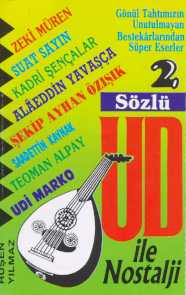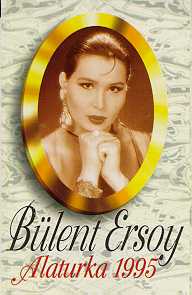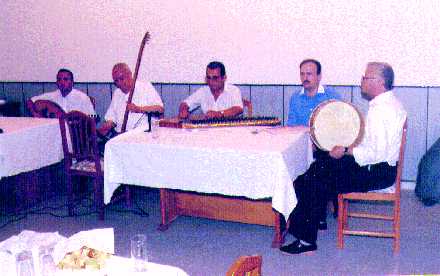2. Nostalgia, commerce and 'The Second Republic'
In more recent years, thanks to CD technology, nostalgia has
become big business. This recent vogue for 'nostalji' has
been promoted on commercial cassettes and CDs with titles which
draw attention to fact - such as, for example, 'Ud ile Nostalji',
'Kanun ile Nostalji' ('Nostalgia with Ud', etc.). Live
performance has followed.
 Cover of Rusen Yilmaz's 'Ud ile
Nostalji' (c. 1994)
|
 |
'Unutturamaz Seni Hic
Bir Sey' 'Unutturamaz
Seni Hic Bir Sey' ('Nothing will make me forget
you'), by Ekrem Guyer. Ekrem Guyer was born in Izmir
in 1921 and spent his working life as a light classical
singer at the Ankara Radio station. He died in 1954: his
most famous compositions were composed in the 1940s and
50s. The example here is performed by Rusen Yilmaz at the
ud (short-necked lute), on a cassette entitled 'Ud ile
Nostalji', the other songs from which largely come from
the 1940s and 50s. A brief taksim improvisation ends, and
the piece begins. The intimate style is closely connected
with a more popular style of nostalgia, and contrasts
markedly with the examples of 'official nostalgia' (see
below).
|
 from
'Alaturka 1995' from
'Alaturka 1995' Bulent
Ersoy released a cassette entitled 'Alaturka 1995', in a
resolutely 'classical' style. It began with a reworking
of Munir Nureddin Selcuk's famous 'Aziz Istanbul', a
somewhat nostalgic view of the city from Camlica, a hill
on the Asian side. Where Munir Nureddin hinted at the
sound of the call to prayer that he imagines coming from
the mosques below him, Bulent Ersoy makes this reference
explicit, singing the call to prayer herself. This caused
outrage in many quarters, since Bulent is a transsexual.
The cassette was, nonetheless, a popular hit.
|
 |
|
Cover of Bulent
Ersoy's Alaturka 1995.
The restrained 'classical' pose marks a somewhat
humourous departure from the erotic poses that she
strikes on other cassette covers. |
Advertisements in papers invite the reader to participate in
'an evening of nostalgia' at such-and-such a gazino (music club).
In fact, my kanun teacher regularly performed in such
clubs.
 |
My kanun teacher and
friends |
|
 |
| My
kanun teacher
and friends (ud, yayli tanbur, def and singer); halfway
through a Nihavent Fasli. All musicians are seated, and
the voice is simply one of an integrated group. |
The French term appropriated by Turks, 'nostalji',
reveals the connection between a certain culturally sanctioned
form of memory and a modernist nationalism which sought quite
explicitly to forget its past. New sound recording technology
(particularly connected with CDs and the digital 'remastering' of
old recordings) has made possible new forms of historical
consciousness, marketed as 'nostalgia'. But this is not merely a
product of a consumer capitalism which turns to the past in
search of novelty. In other senses nostalgia might be interpreted
as a change in popular historical consciousness that accompanies
wider social processes. In particular, I would argue, one should
connect the vogue for nostalgia with a sense of failure
(experienced in a variety of contexts) of the nationalist reform
project. This is a sense of failure that is cast in a temporal
idiom (of 'winding back the clock') precisely because the telos
of Kemalist nationalism has been so resolute, so determined that
no backward glance could ever be permitted. Under threat from the
emerging global economic and political forces that problematise
traditional territorially conceived nationalisms, and, more
specifically, from Islamist resurgence, one might describe
Kemalism as being in a state of nervous retreat. Demands for the
institution of the seriat (Kuranic law) grow increasingly
stronger, and Islamist thinking dominates the local elections
across Turkey (3). A 'Second
Republic' has recently been discussed, in attempts to close the
door on many aspects of Kemalist reformism.
This sense of retreat stems from what is now seen in many
quarters as an inability to live up to the Kemalist legacy, and a
quiet recognition that an ideology which demanded that the past
should be forgotten was untenable.
 |
 Official
nostalgia Official
nostalgia The song is a recording of Tatyos
Efendi's 'Cesm-i Celladin ne Kanlar Doktu Kagithane'de'.
Tatyos Efendi was born in Istanbul in 1855 and died in
1913. The song describes the bitter-sweet torments
suffered by lovers in Kagithane, then a popular excursion
spot, now a slum disrict by the side of the Golden Horn.
The City Council sponsored and released this recording in
1995; the style is close to that of the TRT, with a large
unison orchestra and chorus.
|
| Cover
of Istanbul Sarkilari II, from which the Tatyos Efendi
piece in music example 3 is taken. An orientalist vision
of Istanbul dominates the cover. The English subtitle
indicates both the 'official' nature of the production,
and the fact that it is being marketed for an outside
audience. |
Many Turks today portray the Ottoman past as a moment of
imperial glory when Turks dominated the world stage; a world in
which the various millet (religious minorities) of the
Ottoman empire participated as equals in an East Mediterranean
linguistic, literary, architectural, dietary, and, of course,
musical culture. Sporadic moves against religious minority
communities on the part of the state, and resurgent Islamism in
recent years has often made life for those Armenians, Jews and
Greeks who chose to return to Turkey after 1923 difficult. This
is a bitter pill to swallow for Kemalists: those who still adhere
to Kemalism as a political creed speak (privately) of their
feelings that the process of reform was, perhaps, too quick, too
forceful, and insufficiently attentive to issues of human rights
to succeed in its goals.
The music which represents this golden past, existing, as
music does, in the domain of time and memory, expresses precisely
this complex, gloomy ambivalence for many Kemalists. This is a
music which has, as it were, been made available for nostalgia by
the fact that its history has been denied, or rather, coopted.
This has not been difficult. In a world in which very few people
can read Ottoman script, and cannot master the interpretative
skills to make sense of the few Ottoman musical texts that do
exist, historical research of any kind is impossible for the
majority of Turkish art music practicioners. Historical writing
also implies (or even demands) a sense of critical continuity
which has been politically impossible. For these reasons, Turkish
art music signifies the past, but is constantly presented in ways
that prohibit its reengagement with the present or possible
futures. This process is worth exploring in a little more detail,
since, as a form of historical policing, it is fraught with
problems. When the whole basis of social and cultural order is
based on the premise that the past is irrelevant, or rather, only
relevant in as much as it has been surpassed, how can the past be
materially presented and ideologically controlled in ways which
limit its always subversive implications? This problem is not, of
course, limited to modern Turkey.
Forward | Back | Stokes main
page | References



